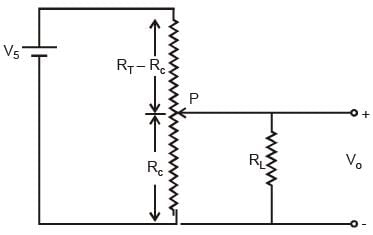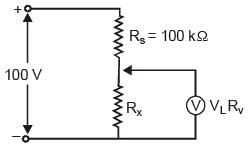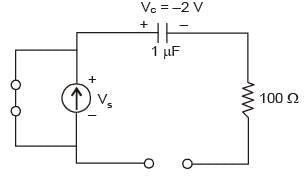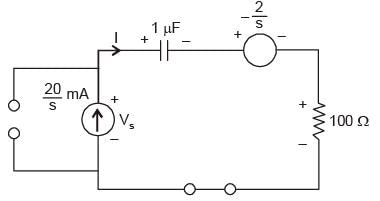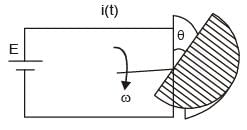Test: Sensor & Industrial Instrumentation- 2 - GATE MCQ
25 Questions MCQ Test - Test: Sensor & Industrial Instrumentation- 2
A well of cross-sectional area aw is connected to an inclined tube of cross-sectional area to form a differential pressure gauge as shown in the figure below. When p1 = p2 the common liquid level is denoted by A. When p1 > p2, the liquid level in the well is depressed to B, and the level in the tube rises by l along its length such that the difference in the tube and well levels is hd. (2007)
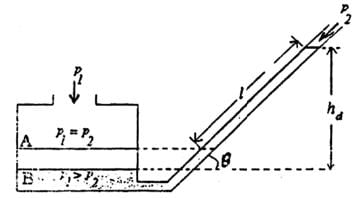
The angle of inclination θ of the tube with the horizontal is

The accompanying figure shows a VERTICAL venturi meter with upward water flow. When the measured static pressure difference, p1 - p2, between the inlet and the throat is 30 kPa, the flow rate is found to be 50 litres per second. Assume that the coefficient of discharge remains the same. (2007)
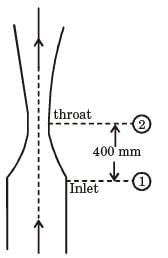
When p1 - p2 = 20 kPa, the flow rate, in litres per second, is

The figure shows a potentiometer of total resistance RT with a sliding contact.
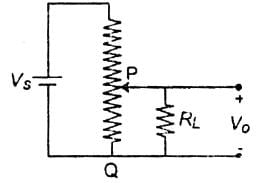
The resistance between the points P and Q of the potentiometer at the position of the contact shown is RC, and the voltage ratio VO / VS at this point is 0.5. If the ratio RL / RT = 1, the ratio RC / RT is (2007)

A 4 kΩ, 0.02 W potentiometer is used in the circuit shown below. The minimum value of the resistance Rs to protect the potentiometer is (2006)
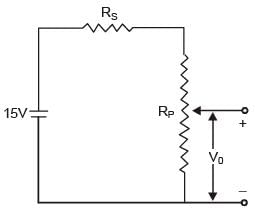
A type J (iron-constantan) thermocouple has a voltage sensitivity of 55 V/°C
A digital voltmeter (DVM) is used to measure the voltage under the condition shown in the following figure. (2006)
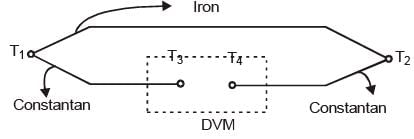
Given that T1 = 3000C, T2 = 1000C and T3 = T4 = 200 C, the meter will indicate a voltage of
A metal wire has a uniform cross-section A, length l, and resistance R between its two endpoints. It is uniformly stretched so that its length becomes α l. The new resistance is (2006)
The secondary induced voltages of an LVDT, shown in the following figure, at the null position are![]() respectively. Then the null voltage of the LVDT is (2006)
respectively. Then the null voltage of the LVDT is (2006)
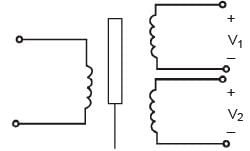
A variable air gap type capacitor consists of two parallel plates: a fixed plate and a moving plate at a distance x. If a potential V is applied across the two plates, then the force of attraction between the plates is related to x as (2006)
The voltmeter is shown in the following figure has a sensitivity of 500 Ω/V and a full scale of 100 V. When connected in the circuit as shown, then the meter reads 20 V.
The value of Rx is (2006)
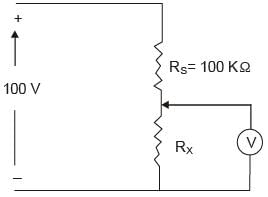
In the circuit shown below, the current through the PMMC meter is assumed to be zero.
The ideal switch toggles between position 1 and position 2. For each position, it is connected for time T / 2. Assume R4 CX < t="" 2="" and="" />2 CX >> T / 2. (2006)
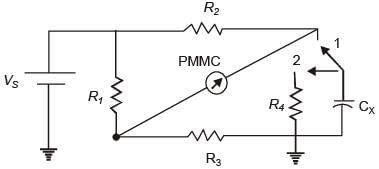
Q. The capacitor CX can be charged up to the maximum voltage
In the circuit shown below, the current through the PMMC meter is assumed to be zero.
The ideal switch toggles between position 1 and position 2. For each position, it is connected for time T / 2. Assume R4 CX < t="" 2="" and="" />2 CX >> T / 2. (2006)
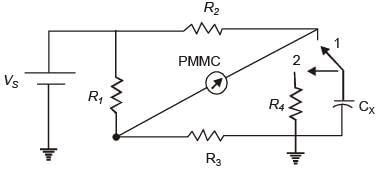
Q. In the bridge circuit shown in the figure above, if the PMMC meter shows null deflection, then the value of CX is
The diameter of an aluminum sphere is found to be 50 mm at atmospheric pressure of 105 Pa. The bulk modulus for aluminum is 68.6 GPa. The change in the diameter of the sphere in microns, when placed in a vacuum is (2005)
In a flyball-type angular speed magnitude measuring device, the centrifugal force, given 10-6 ω2, where ω is the angular speed in rad/s, is transmitted to spring with the non-linear characteristic F = 16π2x2, where F is the applied force and x is the spring compression in meters. The sensitivity of the device in mm.s is (2005)
In a variable-area flowmeter (rotameter), the inlet tube diameter is the same as that of the effective float diameter, and the tube taper is small. When the volume flow rate of a fluid is Q1, the float stands at the height of light from the inlet, and when the volume flow rate of the fluid is Q2, the float moves to a height of 20 mm from the inlet. The ratio of the flow rates Q1 / Q2 is (2005)
In the voltage regulator shown in the figure, the op-amp is ideal. The BJT has VBE = 0.7 V and β = 100 and Zener voltage Vz is 4.7 V for a regulated output of 9 V the value of R in Ω is____. (2014)

In a falling-ball viscometer, the ball attains terminal velocities of 0.01 m/s for oil A and 0.002 m/s for oil B. Assuming the oils have the same density and oil A has a kinematic viscosity of 5 x 10-3 m2/s, the kinematic viscosity of oil B in m2/s is
A thermometer at room temperature 30°C is dipped suddenly into a bath of boiling water at 100°C. It takes 30 seconds to reach 96.5°C. The time required to reach a temperature of 98 °C is (2005)
A mercury barometer reads h mm Hg with the temperature of the mercury at T °C. The barometer reading corrected for the standard temperature 0 °C with p denoting the volumetric expansion coefficient of mercury in 0 °C-1, is h (2005)
A viscous damper consists of a sliding piston and a cylinder filled with the oil of kinematic viscosity 5 x 10-5 m2/s. A damping force of 20 N is applied on the piston and the steady-state velocity reached is 10 mm/s. The damping coefficient of the damper is (2004)
Consider the circuit shown below. Given Vc(0) = - 2V. The value of voltage (VS) across the current source in the circuit is (2014)
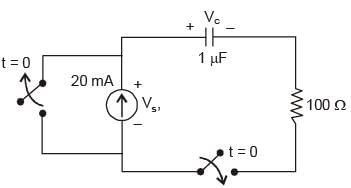
A quartz piezo-electric type pressure sensor has a built-in charge amplifier. The sensor has a sensitivity of 1 V/Pa. It is subjected to a constant pressure of 120 kPa. The output of the transducer at a steady state is (2004)
A pressure sensor has the following specifications Sensitivity at the design temperature = 10 V/MPa, Zero drift = 0.01 V/°C, Sensitivity drift = 0.01 (V/MPa)/°C When the sensor is used in an ambient 20°C above the design temperature, the output from the device is 7.4 V. The true value of the pressure will be (2004)
A variable capacitance angular velocity pickup is made with two concentrically mounted parallel semicircular plates with a small separation between them, as shown in Figure. A dc voltage is connected across the terminals of the capacitance sensor, as shown. For a constant angular velocity ω, the waveform of the current i(t) will be (2004)
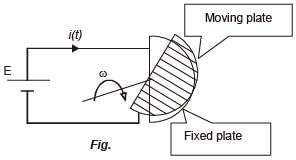
A strain gauge of resistance 120Ω and gauge factor 2.0 is at zero strain condition A 200 kΩ fixed resistance is connected in parallel with it. Then the combination will represent an equivalent strain of (2004)
A single-sensor, contact-type ultrasonic flaw detector uses a frequency of 330 kHz. When testing a specimen, an echo from a flaw is recorded 0.05 mass after the transmitted pulse. If the velocity of sound in the test object is 6.0 km/s, then the flaw is at a depth of (2004)










